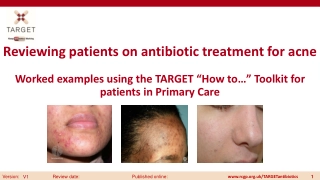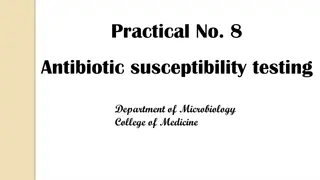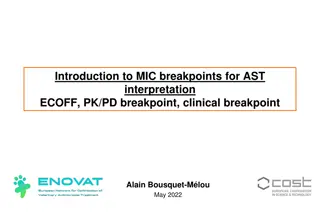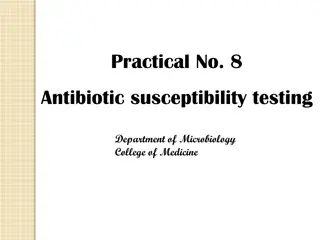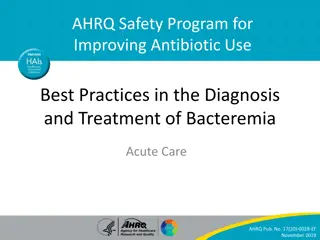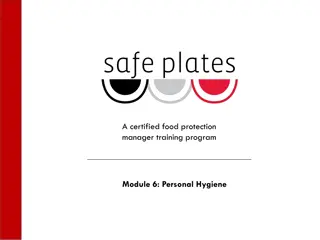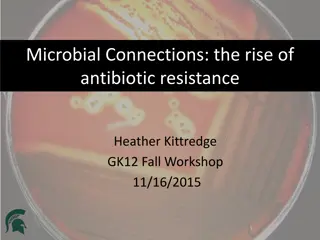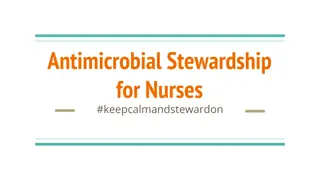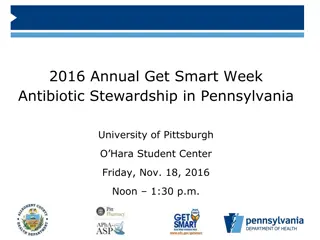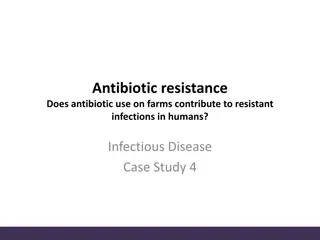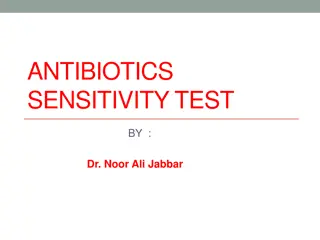Incidence and Antibiotic Susceptibility of Staphylococcus aureus on Door Handles in Ahmadu Bello University
Environmental microorganisms, like Staphylococcus aureus, play a significant role in morbidity and mortality. This study explores the incidence and antibiotic susceptibility profile of Staphylococcus aureus isolated from door handles in Ahmadu Bello University, Zaria, Nigeria. The research aims to assess the level of antibiotic resistance in Staphylococcus aureus to provide better management strategies for associated infections. Sample collection, microbial identification, and susceptibility testing were part of the methodology utilized in this investigation.
Download Presentation

Please find below an Image/Link to download the presentation.
The content on the website is provided AS IS for your information and personal use only. It may not be sold, licensed, or shared on other websites without obtaining consent from the author.If you encounter any issues during the download, it is possible that the publisher has removed the file from their server.
You are allowed to download the files provided on this website for personal or commercial use, subject to the condition that they are used lawfully. All files are the property of their respective owners.
The content on the website is provided AS IS for your information and personal use only. It may not be sold, licensed, or shared on other websites without obtaining consent from the author.
E N D
Presentation Transcript
Incidence And Antibiotic Susceptibility Profile Of Staphylococcus aureus On Door Handles In Ahmadu Bello University, Zaria, Nigeria. Onaolapo J. A.*, Afolabi O. E and Igwe J. C. Department of Pharmaceutics and Pharmaceutical Microbiology, Ahmadu Bello University, Zaria.
PRESENTATION OUTLINE Introduction Methodology Results and Discussion Conclusion Recommendations References
INTRODUCTION Environmental microorganisms which are of clinical importance, due to their contribution to morbidity and mortality is increasing daily. contamination with pathogenic Such microorganisms especially skin associated ones like Staph. aureus have been isolated from various sites or surfaces touched by hands both in hospitals and non- hospital environments (Benjamin et al., 2013; Adriano et al., 2011; Josh, 2011).
This wide spread of Staph. aureus contributes to its importance as a nosocomial and community-acquired pathogen, whose genetic plasticity could facilitate the evolution of many virulent and antibiotics resistant strains, which could present a major and constantly changing clinical problems (Matthew et al., 2004). As a means of checkmating the global challenges associated with antibiotic resistance in microorganism, this study evaluates the antibiotics susceptibility profile of Staph. aureus isolated from door handles in the Faculty of Pharmaceutical Sciences and Amina female hostels inAhmadu Bello University, Zaria, Nigeria in order to quantify the level of antibiotics resistance and to proffer better treatment or management options to infections associated with Staph. aureus contacted from door handles in this area.
METHODOLOGY Sample Collection A total of one hundred and forty three (143) samples from door handles were randomly collected using sterile swab sticks containing sterile normal saline. The samples were aseptically collected from Amina female hostel, Pharmacy main block and Pharmacy old block of Ahmadu Bello University Zaria, Samaru Campus (A.B.U).
Microbial Identification, Isolation and Microscopy Collected samples were suspended in sterile nutrient broth for 24hrs and then inoculated on the surface of sterile nutrient agar (NA), and incubated at 37OC for 18hrs. Gram staining and microscopy using the method described by Chakraborty and Nishith, (2008), while colonies as described by Cheesbrough (2000). further morphological characterization of the
Biochemical Test The following conventional biochemical tests; catalase, coagulase and oxidase tests described by Cheesbrough (2000) were adopted to distinguish Staph. aureus from other forms of Staph. spp. While the Gram negatives organisms were identified by their colour on indole, methyl red, Vogue Prosker, citrate and urease described by Chakraborty and Nishith (2008).
Antibiotic Susceptibility Test and Multiple Antibiotic Resistance Index (MARI) Evaluation The susceptibility profiles of the identified Staph. aureus was tested against twelve (12) selected antibiotics using disc diffusion method as described by Cheesbrough (2000) and the corresponding results interpreted using CLSI (2014). The multiple antibiotic resistant (MAR) index was determined for each isolate. This is defined as the number of antibiotics to which the organism is resistant to, divided by the total number of antibiotics tested (Paul et al., 1997).
RESULTS AND DISCUSSION Out of the 143 door handles sampled, the incidence of Staph. aureus was 23.8% (34) with highest occurrence inAmina female hostel (16.8%), followed by Pharmacy main block (4.2%) and Pharmacy old block (2.8%) as shown in Table 1.
Table 1: Distribution of Staph. aureus In Door Handles in Ahmadu Bello University, Zaria S/N Sample Source No. Of Sample Number of Percentage of Staph. Staph. aureus Collected aureus (%) 1 Amina female hostel 89 24 35.8 2 Pharmacy main block 40 6 8.9 3 Pharmacy old block 14 4 6.0 Total 143 34 50.7
Among the samples collected, culture identification, microscopy and biochemical tests also showed the presences of other microorganisms. The incidence of E. coli (9%) and Shigella dysentery (7.5%) were found to be the most common bacteria compared to other microorganisms isolated after Staph. aureus. This is shown in Table 2.
Table 2: Percentage of Bacteria Isolated from the Door Handles Sampled This result showed the microbial contaminate on door handles in the areas sampled. S/N 1 2 3 4 5 6 7 8 9 10 11 ORGANISMS Staphylococcus aureus Eschericheria coli Shigella dysentery Salmonella typhi Pseudomonas aeruginosa Serretia spp. Klebsiella spp. Citrobacter spp. Proteus mirabilis Salmonella paratyphi A Enterobacter spp. Number of Isolates (n = 67) Percentage (%) 34 6 5 4 4 4 3 2 2 2 1 67 50.7 9 7.5 6 6 6 4.4 3 3 3 1.4 100
Antibiotics Susceptibility Profile of Staph. aureus from the Sampled Areas The isolates were highly susceptible to Erythromycin, Ciprofloxacin, and Tetracycline (100%), 97% susceptible to mupirocine and cotrimoxazole, 90% to Pefloxacine, and 85% to Oxacillin. But the isolates were observed to be 100% (34) resistant to Cefotaxime and Amoxicillin, 96.7% (33) resistant to Cefuroxin sodium, 76.6% and 70 % resistant to Ofloxacine and Amoxicillin clavulanic acid respectively (Figure 1).
120 100 100 100 100 100 97 97 96.7 100 90 85 76.6 80 70 Percentages Susceptible Intermidiate Resistance 60 40 23.3 20 9 8 6.7 3 3 2 0 0 0 0 0 0 CIP PEF TE MUP SXT CTX CXM E OX AMC OFX AML Antibiotics Figure 1: Antibiotics Susceptibility Profile of Staph. aureus Keys: Tetracycline (TE), Cefuroxin sodium (CXM), Cefotaxime (CTX), Mupirocin (MUP), Ciprofloxacin (CIP), Ofloxacin (OFX), Perfloxacin (PEF), Oxacillin (OX), Erythromycin (E), Amoxicillin/clavulanic acid (AMC), Amoxicillin (AML), Cotrimoxazole (SXT).
Table 3: Evaluation of the Antibiotic Resistance Pattern and Index (MARI) of Staph. aureus This result showed the antibiotic susceptibility profile of the Staph. aureus isolated from door handles in the areas sampled Antibiotics Resistant Pattern MARI CART DR S/N ISOLATES 1 F1a 2 D2b 3 I1b 4 H1b 5 H2c 6 K2b 7 I2 8 L1a 9 F1b 10 E2a 11 F2b 12 D2c 13 A2b 14 A2a 15 H1a CTX, CXM, AML CTX, CXM, AML, OFX AMC, CTX, CXM, AML, PEF, OFX AMC, CTX, CXM, AML, OFX AMC, CTX, CXM, AML, OX, OFX CTX, CXM, AML, CTX, CXM, AML, OFX AMC, CTX, CXM, AML, OFX AMC, CTX, CXM, AML, OFX AMC, CTX, CXM, AML, PEF, OFX AMC, CTX, CXM, AML, OFX AMC, CTX, CXM, PEF, AML, OFX AMC, CTX, CXM, AML, AMC, CTX, CXM, AML CTX, OX, OFX, AML, 0.3 0.3 0.5 0.4 0.5 0.3 0.3 0.4 0.4 0.5 0.4 0.5 0.3 0.3 0.3 CEP, BET CEP, BET CEP, BET, FLU CEP, BET, FLU CEP, BET, FLU CEP, BET CEP, BET, FLU CEP, BET, FLU BET, CEP, FLU BET, CEP, FLU BET, CEP, FLU BET, CEP, FLU BET, CEP BET, CEP CEP, BET, FLU XDR XDR MDR MDR MDR XDR MDR MDR XDR MDR MDR MDR XDR XDR MDR
CTX, CXM, AML, OFX CTX, CXM, OFX, AML, AMC, CTX, CXM, AML, OFX CTX, CXM, AML, OFX AMC, CTX, CXM, OFX, MUP, AML CTX, CXM, AML, AMC, CTX, CXM, OFX, AML, CTX, CXM, AML, OFX AMC, CTX, CXM, AML, OFX AMC, CTX, CXM, AML AMC, CTX, CXM, AML, OX, OFX AMC, CTX, CXM, AML, OFX AMC, CTX, CXM, AML, OFX AMC, CTX, CXM, AML, OFX AMC, CTX, CXM, AML, AMC, CTX, CXM, AML, 0.3 0.3 0.4 0.3 0.5 0.3 0.4 0.3 0.4 0.3 0.5 0.4 0.4 0.5 0.3 0.3 BET, CEP, FLU CEP, BET, FLU BET, CEP, FLU BET, CEP, FLU BET, CEP, FLU, PS CEP, BET BET, CEP, FLU CEP, BET FLU BET, CEP, FLU BET, CEP BET, CEP, FLU BET, CEP, FLU BET, CEP, FLU BET, CEP, FLU BET, CEP BET, CEP MDR MDR MDR MDR MDR XDR MDR MDR MDR XDR MDR MDR MDR MDR XDR XDR 16 17 18 19 20 21 22 23 24 25 26 27 28 29 30 I1a H1c G2a H2b B1a J2 F2a D1b K1b L1b M1a M1b N2a N2b H2a M2p 31 N2c AMC, CTX, CXM, AML, SXT, OFX 0.5 BET, CEP, FLU, FPI MDR 32 N2g AMC, CTX, CXM, AML, OFX 0.4 BET, CEP, FLU MDR 33 D2h AMC, CTX, CXM, AML, OFX 0.4 BET, CEP, FLU MDR 34
Keys: Tetracycline (TE), Cefuroxin sodium (CXM), Cefotaxime (CTX), Mupirocin (MUP), Ciprofloxacin (CIP), Ofloxacin (OFX), Perfloxacin (PEF), Oxacillin (OX), Erythromycin (E), Amoxicillin/clavulanic acid (AMC), Amoxicillin (AML). Class of antibiotics resistant to (CART), Degree of resistance (DR), Betalactam/Betalactamase inhibitors (BET), Folate pathway inhibitors (FPI), Cephalosporine (CEP), Fluoroquinolone Pseudomonic acid (PS). (FLU), Macrolide (MAC), MDR: Multidrug-resistant, XDR: Extensively drug-resistant NIL: neither MDR nor XDR. MDR: non-susceptible to 1 agent in 3 antimicrobial categories. XDR: non-susceptible to 1 agent in all but 2 categories. PDR: non-susceptible to all antimicrobial agents listed. PDR was not considered because not all the antibiotics contained in the proposal of Magiorakos et al., (2012) are used in this study.
CONCLUSION This study on Staph. aureus from door handles in A.B.U Zaria have proved that door handles could serve as reservoir and route of microbial dissemination in disease outbreak. It also suggests ciprofloxacin, erythromycin, tetracycline, mupirocin and oxacilline as the best antibiotics during infection associated with door handle Staph. aureus. It also encourages the need to promote proper hygienic practice and adherence to antibiotic treatment in order to prevent the spread of resistance bacteria.
RECOMMENDATIONS For immediate action, this study suggests the use of silver coated door handles with antimicrobial activity in other to reduce the microbial load from this source, and frequent use of disinfectant/hand recommended. sanitizer is Also proper periodic antibiotic surveillance should be encouraged to have referable documentaries in disease outbreak.
REFERENCES Adriano Menis Ferreira, Denise de Andrade, Marcelo Alessandro Rigotti, Margarete Teresa Gottardo de Almeida (2011). Methicillin-resistant Staphylococcus aureus on surfaces of an Intensive Care Unit. Acta paul. enferm., 24 (4) Benjamin A. Miko, Carolyn T. A. Herzig, Dhritiman V. Mukherjee, Montina Befus, Zoltan L. Apa, Ruo Yu Bai, Caroline J. Lee, Anne-Catrin Uhlemann, Elaine L. Larson, and Franklin D. Lowy (2013). Is Environmental Contamination Associated with Staphylococcus aureus Clinical Infection in Maximum Security Prisons?. Infect Control Hosp Epidemiol. 34(5): 540 542. Charkraborty.P,Nishith Pal. (2008). Manual of practical microbiology and parasitology. 11th edition. New central book agency(P) Ltd., 40(79):112-131. Cheesbrough M (2000). District laboratory practice in tropical countries (Part 11). Cambridge, University Press UK. Pp. 134-143. Clinical Laboratory Standard Institute (CLSI) (2014). Performance Standards for Antimicrobial Susceptibility Testing; Twenty-Fourth. This document provides updated tables for the Clinical and Laboratory Standards Institute antimicrobial susceptibility testing standards M02-A11, M07-A9, and M11-A8. 30(1)
Josh (2011). Microbial biography of public rest room surfaces.Word press and Atahualpa Magiorakos A.P., Srinivasan A., Carey R. B., Carmeli Y., Falagas M. E., Giske C. G., Harbarth S., Hindler J. F., Kahlmeter G., Olsson-Liljequist B., Paterson D. L., Rice L. B., Stelling J., Struelens M. J., Vatopoulos V, Weber J. T. and Monnet D. L. (2012). Multidrug-resistant, extensively drug-resistant and pandrug-resistant bacteria: an international expert proposal for interim standard definitions for acquired resistance. Clinical Microbial Infection, 18: 268 281 Matthew T. G. Holden, Edward J. Feil, Jodi A. Lindsay, Sharon J. Peacock, Nicholas P. J. Day, Mark C. Enright, Tim J. Foster, Catrin E. Moore, Laurence Hurst, et al., (2004). Complete genomes of two clinical Staphylococcus aureus strains: Evidence for the rapid evolution of virulence and drug resistance. Proceedings of the National Academy of Sciences of the United States of America, 101(26): 9786 9791 Paul, S. Bezbarauh, R.L. Roy, M. K and Ghosh, A.C. (1997). Multiple antibiotics resistance (MAR) index and its reversion in Pseudomomas aeruginosa. Letters in Applied Microbiology, 24:169-71
THANKS FOR LISTENING


